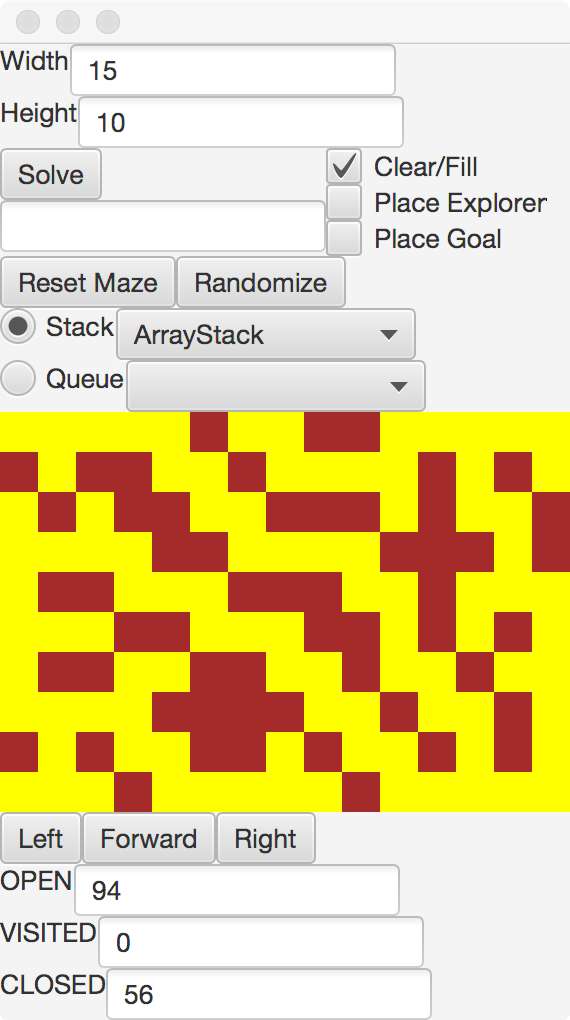
But there are other ways to search. We now want to investigate a breadth-first search approach, where the oldest potential trail is expanded next.
In this lab, you will create the necessary data structures to search a maze with either a depth-first search or breadth-first search.
To start, run the code in MazeApp. After you click on "Randomize", you should see the GUI layout here.

There are a few new pieces to this GUI. First, you will see a way for you to
select a search strategy, either a Stack or a Queue. For each strategy, you
will see a list of implementations available. To start, you will find the code
for the ArrayStack
Second, you will notice that there are statistics in the lower portion of the
GUI, recording the number
Third, there is an error box underneath the Solve button, to report when things
go wrong with the underlying implementations. It will also report the number of steps
taken when a solution trail is found through searching.
This project contains a working implementation of the Maze Lab and Project,
so you do not have to revise any of your earlier code to add this functionality.
While the name of the file is
Note that there is an additional method to implement. For ListNode implementations, the
While the name of the file is
While the name of the file is
Your code needs to be efficient in terms of the space used. You should treat
your array of elements as a circular array, and only resize the array
when all positions are full of valid elements in the queue.
The
Use this data to compare the Stack versus Queue search strategies. Does either strategy
have any clear strengths or weaknesses?
maze.models.searchers directory.
Step 1 - ListNode<E>
To implement the generic version of a Stack and Queue with nodes, your
first task is to reimplement the Node class to be Generic. All of your implementations
for this lab will be located in the maze.models.searchers directory.
Step 1.1 - Implementation
You will first need to create a file called ListNode.java that implements the Node class we
discussed. It should have an E value, and a ListNode next reference as
components, along with get and set methods for the
value and next fields.
ListNode.java, the name of your
class should be ListNode<E>.
Step 2 - ListStack<E>
We next revise your earlier ListIntStack code to be a generic implementation.
Step 2.1 - Implementation
Write a class called ListStack<E>. This will
need to implement the Stack<E> interface, and have at least a
ListNode<E> called top as a field.
capacity method should return the size.
Step 2.2 - Testing
Run the ListStackTest suite, and ensure your above methods are passing these tests.
Step 2.3 - GUI
Now, run the MazeApp class, and test out your code with the GUI. You should be
able to select between the ArrayStack and ListStack implementations.
Step 3 - ListQueue<E>
Now that you are comfortable with generic implementations, write a Queue using the
ListNode<E> from Step 1.
Step 3.1 - Implementation
Your implementation will have two fields as discussed in class, a head and a tail.
Create a new Class, implementing the Queue<E> interface
and completing all of the necessary methods.
ListQueue.java, the name of your
class should be ListQueue<E>.
Step 3.2 - Testing
Test out your code with the ListQueueTest suite
Step 3.3 - GUI
Run the GUI to interact with
your code. There should be an available implementation in the Queue section.
Step 4 - ArrayQueue<E>
Finally, write a Queue using an array-based implementation.
Step 4.1 - Implementation
Your implementation will have three fields as discussed in class, a head index field and a size
field, plus a generic array of type E elements.
Create a new Class, implementing the Queue<E> interface
and completing all of the necessary methods.
ArrayQueue.java, the name of your
class should be ArrayQueue<E>.
capacity of the Array implementations is the length of the array
used to store the elements.
Step 4.2 - Testing
Verify that your ArrayQueue is working with the ArrayQueueTest suite.
Step 4.3 - GUI
Run the GUI to interact with
your code.
Step 5 - Evaluation
Create 10 mazes of size 30x30 and for each maze and strategy (Stack and Queue), record the number of visited nodes as a percentage of
the total number of open spaces in the initial maze. You can choose either implementation
for each data type.
What to Hand In
Submit your ListNode.java, ListStack.java, ListQueue.java and ArrayQueue.java implementations,
along with a document for your evaluation in Step 5.
Grading
© Mark Goadrich, Hendrix College